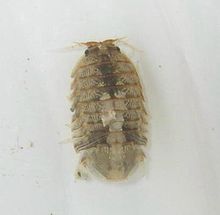- Gnorimosphaeroma oregonensis
-
Gnorimosphaeroma oregonensis 
Scientific classification Kingdom: Animalia Phylum: Arthropoda Subphylum: Crustacea Class: Malacostraca Order: Isopoda Family: Sphaeromatidae Genus: Gnorimosphaeroma Species: G. oregonensis Binomial name Gnorimosphaeroma oregonensis
(Dana, 1853) [1]Synonyms Sphaeroma oregonensis Dana, 1853
Gnorimosphaeroma oregonensis, the Oregon pill bug, is a small intertidal macroinvertebrate isopod crustacean.
Contents
Description
It is an oval-shaped organism roughly 6 mm in length,[2] and about twice as long as it is wide. G. oregonensis is covered in a grey-coloured rigid shell, which is roughly uniform in colour except for a thin band that extends from the head to the end of the organism, and progresses from dark grey to light grey respectively. At the head, G. oregonensis possesses antennae, a mouth (for feeding), and eyes, and its body is lined with seven pairs of small legs, used for crawling when the organism is young, and for swimming later in life. Gills are located on the animal's belly, and are the mechanism by which the animal breathes.
Ecology
Habitat
The primary habitat of G. oregonensis is the mid-Californian to Alaskan coast, where it inhabits tidal pools and the intertidal region up to depths of 24 metres (79 ft).[3] They live in very large and frequent families, with dozens or even hundreds being found per tenth of a metre in places where they are most abundant, such as the San Francisco Bay, where they are the most common isopod found.[2] Their substrates of choice are gravel, sand, and loose rocks on rocky beaches in the aforementioned areas, although they can also be found living amongst algae.
Tolerance of abiotic factors
The salinity that G. oregonensis is commonly found in ranges from 9 to 31‰, which is a relatively wide range, although they prefer areas of lower salinity. Osmoregulation in G. oregonensis is primarily dependent on where the population originated, and the organism is very proficient in adapting to changes in salinity, temperature, and humidity, meaning in can withstand fairly large ranges of all three of these factors. G. oregonensis also has the ability to tolerate relatively low levels of oxygen, which is common to polluted water. Competition with other marine isopods and crustaceans, as well as mussels and barnacles, is a biotic factor that limits the range of G. oregonensis, but its aforementioned abilities to withstand many changes in its environment as well as to survive in polluted water make it a fairly successful competitor.
Feeding
Other than for transport, G. oregonensis uses its legs for scavenging dead organic material from the substrates of ponds and streams. G. oregonensis is therefore a primarily a detrivore, although it also feeds on diatoms and the eggs of other organisms. It generally prefers a herbivorous diet. G. oregonensis is preyed on by a wide variety of consumer species, including other isopods and invertebrates, as well as many species of fish.
References
External identifiers for Gnorimosphaeroma oregonensis EOL 344702 ITIS 92296 NCBI 142073 WoRMS 260464 - ^ Richard C. Brusca, Vânia R. Coelho & Stefano Taiti (2001). "List of All California Marine Isopods". http://tolweb.org/tree/eukaryotes/animals/arthropoda/crustacea/isopoda/accessory/caguide/allcaisopods.html.
- ^ a b Edward F. Ricketts, Jack Calvin, David W. Phillips & Joel W. Hedgpeth (1992). "Rocky shores of bays and estuaries". Between Pacific Tides (5th ed.). Stanford University Press. pp. 269–316. ISBN 9780804720687. http://books.google.co.uk/books?id=tUl5ESavtRIC&pg=PA275.
- ^ Richard C. Brusca, Vania R. Coelho & Stefano Taiti (2007). "Isopoda". In Sol Felty Light & James T. Carlton. The Light and Smith Manual: Intertidal Invertebrates from Central California to Oregon (4th ed.). University of California Press. pp. 503–541. ISBN 9780520239395. http://books.google.co.uk/books?id=64jgZ1CfmB8C&pg=PA537.
- Segal & Burbanck, 1963. The Biology of Crustacea Volume 5. Academic Press Inc.
- Schultz, G. 1969. The Marine Isopod Crustaceans. WM. C. Brown Company Publishers.
- Warburg, M. R. 1978. Evolutionary Biology of Land Isopods. Springer – Verlag Berlin Heidelberg.
Categories:- Sphaeromatidea
- Indo-Pacific crustaceans
- Animals described in 1853
Wikimedia Foundation. 2010.
